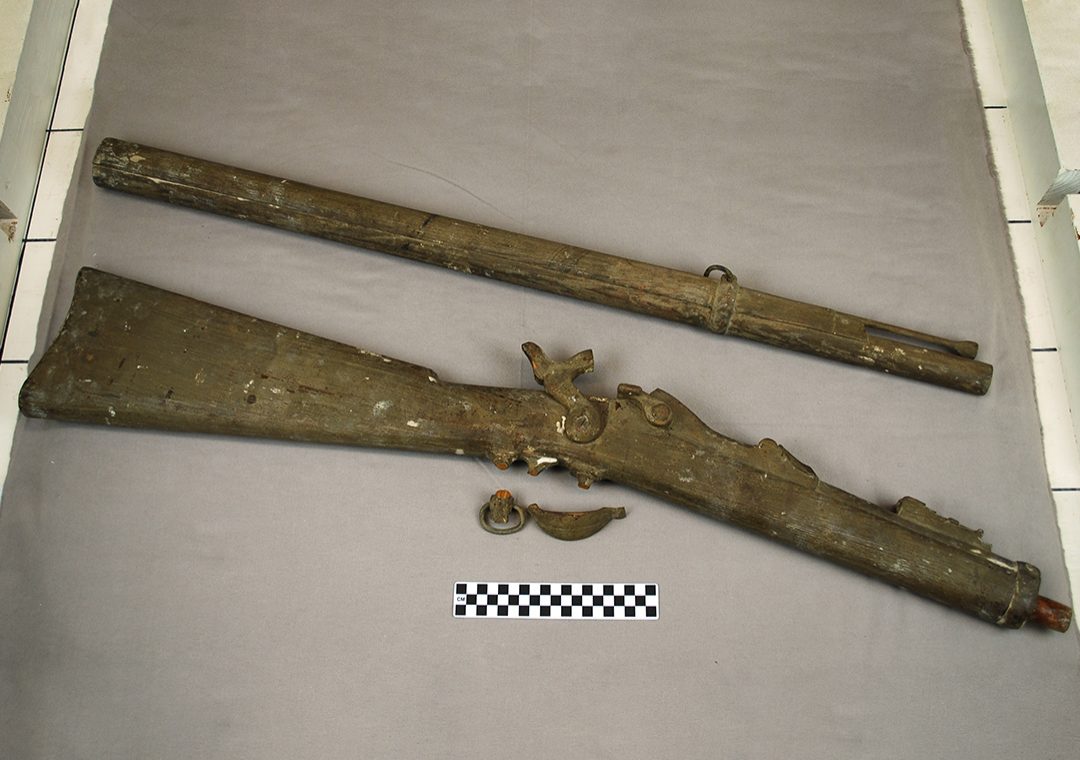This wooden gun was used by the Italian sculptor Pompeo Luigi Coppini as a model for one of his sculptures. Although Coppini would later become one of the most revered sculptors in Texas, it took him a while to make his way here. Born in 1870 in Moglia, Mantua, Italy, Coppini spent the majority of his time in Florence, Italy. While in Florence he studied under Augusto Rivalta at the Academia di Belle Arti until he graduated with honors in 1889. He would stay under the guidance of Rivalta until 1896 when he immigrated to the US where he met his wife, Elizabeth Di Barbieri .
In 1901 Coppini moved to Texas to help the German sculptor Frank Teich fulfill a new order for Confederate memorials. While working under Teich, Coppini was put in charge of making a monument to Jefferson Davis with four Confederate soldiers on the Texas capitol grounds. His work was so impressive that he was able to generate his own commissions, often competing with his former boss Teich. The commissions kept rolling in, in 1903 alone he was commissioned to work on the statue of Rufus C. Burleson at the University of Baylor in Waco, TX, as well as busts of the Confederate Generals Johnston , Lee, Jackson and Confederate President Jefferson Davis for a monument in Paris, TX. On top of all of those commissions, he also worked on a group of statues called the “Victims of the Galveston Flood” for the University of Texas. His work didn’t stop there, in 1905-1907 he worked on an equestrian monument of Terry’s Texas Rangers (the Eighth Texas Confederate Cavalry), which is also located on the Texas Capitol grounds. In 1910 he completed the bas relief for Sam Houston’s tombstone in Huntsville, TX, as well as finishing the Texas Revolutionary Monument in Gonzales, TX.
These are just a few early examples of Coppini’s works, it would not be until the late 1920s-1930s that Coppini would produce two of his most influential and iconic pieces; The Littlefield Fountain Memorial on the grounds of the UT campus (1920-1928) and the “Spirit of Sacrifice: the Cenotaph to the Heroes of the Alamo” (1937-1939). The Littlefield fountain was one of the few sculptures that Coppini worked on outside of Texas. Moving from his studio in San Antonio in 1916 in order to cast the bronze for the Littlefield fountain. He would first move to Chicago for short period of time, then three years later to New York to oversee the casting of the fountain; its purpose was to symbolize the reunion of the North and South. He would later move back to San Antonio in 1937 to reopen his studio on 115 Melrose Place, to work on the “Spirit of Sacrifice.” The cenotaph is one of Coppini’s largest works, the base alone is 12 feet by 40 feet. The cenotaph is 60 feet tall and is covered in Coppini’s extraordinarily detailed bas relief figures; some of the figures, like William B. Travis, stand at least 25 feet tall.
In 1931, his home country of Italy awarded him the title of Commendatore of the crown of Italy for his works in America. In 1934, Centennial Commissions awarded him a commemorative half-dollar for the bronze statues in the Hall of States. In 1941 the University of Baylor gave Coppini an honorary doctorate degree in fine art. He would also be art director at Trinity University for a few years. He went on to found the Coppini Academy of Fine Arts in San Antonio, in 1945. Located in his old studio, Coppini would teach and sculpt here until his death in 1957. The school is still open today, and when it’s not hosting fine art classes, it serves as a museum of Coppini’s life and works.
